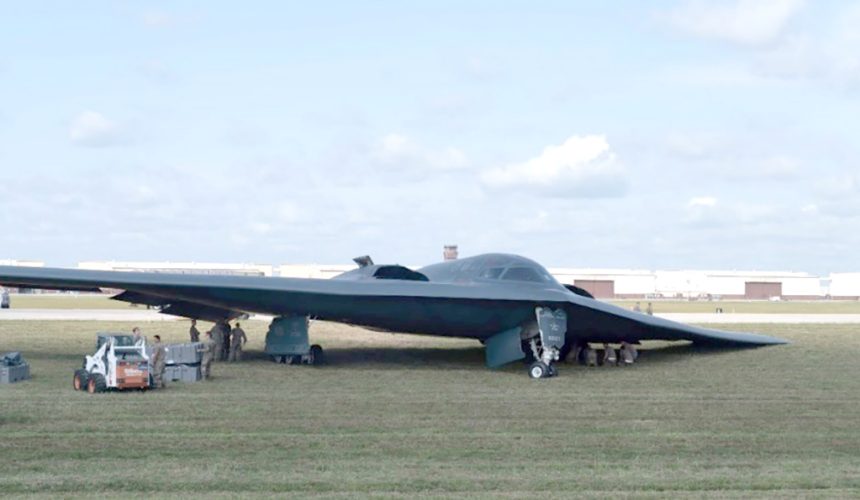Old springs led to the collapse of the left main landing gear that resulted in 10M USD damage to a B-2A Spirit stealth bomber at Whiteman Air Force Base last year.
On Sept. 14, 2021, at 00:19 LT, a B-2A Spirit, assigned to the 393d Bomb Squadron (393 BS) of the 509th Bomb Wing (509 BW), experienced a left main landing gear (LMLG) collapse while landing on the runway at Whiteman Air Force Base, Missouri. As a consequence of the collapse, the stealth bomber, tail number 89-0129 (“Spirit of Georgia”), skidded off runway until it came to a stop about 1 mile from the touchdown point.
Following the incident, a Temporary Flight Restriction was activated with a six nautical miles radius around the air base from ground to 8,000 feet, with the reason listed in the NOTAM (NOtice To AirMen) as “to provide a safe environment for accident investigation”.
According to an AIB (accident investigation report) that Air Force Global Strike Command has just released, the aircraft “suffered significant damage due to the initial gear collapse and the resulting dragging of the wing along the runway. Preliminary estimates put the cost of repairing the MA at a minimum of $10.1 million, though further assessment of the MA will be required to determine a final cost.”
Indeed, shortly after the incident, TWZ had obtained satellite images of Whiteman AFB via Planet Labs, which were captured at around 10:30 AM local time on September 15. The image showed the B-2 that had veered off the runway and multiple vehicles and equipment as the recovery and mishap investigation were already in progress when the image was taken.

“The Abbreviated Accident Investigation Board (AAIB) President found, by a preponderance of the evidence, the cause of the mishap was that the MA’s [Mishap Aircraft] LMLG [Left Main Landing Gear] lock link springs failed to provide sufficient pressure to maintain the lock links in the locked position, which resulted in a LMLG collapse during the MA’s landing. Further, the AAIB President found, by a preponderance of the evidence, that one factor substantially contributed to the mishap: the failure of a hydraulic CryoFit coupling that drove a rapid a loss of hydraulic fluid in the #1 and #4 hydraulic systems, which isolated the LMLG lock link actuator and prevented its use in assisting the LMLG lock link to remain down and locked.”
“The collapse caused a structural failure of the LMLG hydraulic retract actuator and caused the violent separation of the LMLG door as the MA settled onto its left side. The settling of the MA then caused the failure and separation of the lower half of the left rudder and caused extensive lower left wing damage as the MA continued its landing roll down the runway, resting on the NLG, RMLG and the left lower rudder/wing tip. In the B-2A, the landing gear lock links are primarily held in place by the mechanical action of two lock link springs, which hold the lock link in the over center (locked) position. The lock link is assisted into the over center position by a hydraulic lock link actuator which maintains pressure on the lock link. However, the actuator is not required for normal landing gear operation. The landing gear is designed to operate mechanically, using the force of gravity and airflow to extend into a down and locked position without any hydraulic assistance. The evidence for this design is seen in the RMLG of the MA, which extended solely with gravity and airflow, and which remained down and locked without any hydraulic assistance.”
“Over the history of the B-2A, there have been eight previous cases of a dual failure of the #1 and #4 hydraulic systems in flight, at least four of which included the use of the emergency landing gear extension system; however, none of those failures resulted in a landing gear collapse. The only previous landing gear collapse of a B-2A occurred in 2002 in a hangar when the aircraft was undergoing maintenance on a landing gear proximity sensor. In that case, there was no power on the aircraft and consequently no hydraulic assistance holding the lock link over center. In order to adjust the proximity sensor on the lock link, aircraft maintenance personnel removed the landing gear lock link safety pin, in violation of technical orders, and pushed up on the lock link. This action caused the lock link to disengage from the over center position and the landing gear to rapidly collapse. The fact that an individual was able to break the lock link’s over center by simply pushing up on it illustrates the relatively small amount of force required to break the over center (locked) position when it is not assisted by the hydraulic lock link actuator.”
Those springs that caused the landing gear collapse were found to be outside the tolerance level and producing about 11% less tension than they were designed to provide. In fact, they were old and possibly never removed and replaced.
“Since 2018, B-2As going through programmed depot maintenance (PDM) have had their lock link springs removed and replaced. The MA had not been through depot since this change in procedure, and a thorough search of the MA’s maintenance records found that the springs had not been replaced in the last ten years. No evidence could be found that the springs had ever been replaced.”
The report doesn’t say how long will repairing the B-2 require. Depending on the extent of the damage, fixing the bomber and its skin can take some time. For instance, another B-2, which was heavily damaged by fire, was able to fly again after a four-year repair effort in 2014. The only total loss for the B-2 Spirit remains the one crashed on departure from Guam in 2008.









